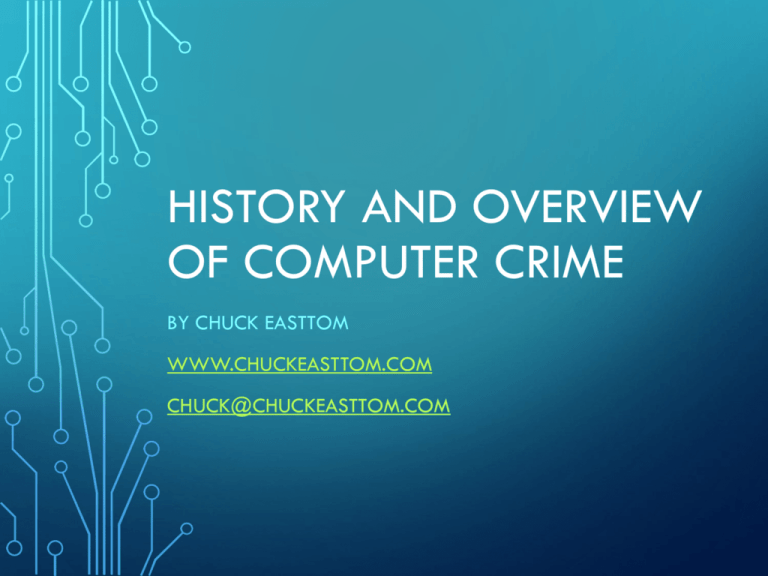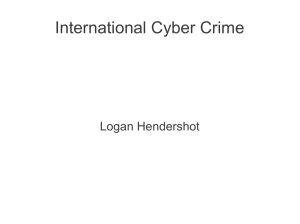Brief Presentation
advertisement

HISTORY AND OVERVIEW OF COMPUTER CRIME BY CHUCK EASTTOM WWW.CHUCKEASTTOM.COM CHUCK@CHUCKEASTTOM.COM ABOUT THE SPEAKER • 18 books (#19 in progress) • 29 industry certifications • 2 Masters degrees (#3 in progress) • 5 Computer patents • Over 20 years experience, over 15 years teaching/training • Frequent consultant/expert witness www.chuckeasttom.com chuck@chuckeasttom.com TYPES OF COMPUTER CRIME • • • • • • • • • • • • Identity theft Cyber stalking/harassment Unauthorized access to computer systems or data Fraud DOS Virus Worm Logic Bomb Trojan Horse Spyware Child pornography DNS Poisoning • • • • • • • • • • • • • Ransomware Buffer Overflow Cyber espionage & terrorism ID Theft Social Engineering Phreaking SQL Injection Cross Site Scripting DNS Poisoning Session Hijacking IP spoofing/MAC spoofing Terrorism Stolen goods COMPUTER CRIME STATISTICS From January 1, 2009 through December 31, 2009, the Internet Crime Complaint Center (IC3) Web site received 336,655 complaint submissions The Federal Trade Commission found that in 2005, 8.3 million Americans were the victim of some form of identity theft Every second, $3,075.64 is being spent on pornography, 28,258 Internet viewers are viewing pornography, 372 Internet users are typing adult search terms into search engines, and every 39 minutes, a new pornographic video is made in the United States. Also according to Enough is Enough, pornography is a 97 billion dollar a year business, and child pornography is a 3 billion dollar a year business STATISTICS AS OF 2014 • According to SC Magazine “Cyber crime and economic espionage cost the global economy more than $445 billion annually, which a report from the Center for Strategic and International Studies, says puts cyber crime on par with the economic impact of global drug trafficking. “ ADDITIONAL STATISTICS • These are as of 2013 • More than 600,000 FaceBook accounts are compromised every day. • 18 Cybercrime victims per second • Botnets have been using as many as 120,000 infected “zombie” computers to send out spam each day. ATTACK TYPES 2013 INDUSTRIES THE EARLIEST DAYS • Mr. Draper was known in hacking circles as ‘Captain Crunch’. He was repeatedly arrested throughout the 1970’s on charges of phone tampering. This particular case is very interesting because it highlights the state of computer related crimes prior to the internet. In those early days most of the incidents involved tampering with phone systems. This process is colloquially referred to as ‘phreaking’. Phreaking is really the ancestor of later hacking, and not surprisingly many of the people involved in phreaking moved on to become hackers. John Draper is one of the more famous hackers, and has since become a computer security consultant. FIRST COMPUTER CRIME ARREST The year 1981 was a pivotal year in the history of computer crime. In this year Ian Murphy was arrested because he and three accomplices hacked into the AT&T systems and changed their system’s internal clocks. This change may seem trivial, but had significant repercussions. People using the phone system suddenly received late-night discounts in the afternoon, while others who waited until midnight to use the phone received larger bills. FIRST VIRUS 1981 was not only the year of the first arrest for a computer crime, it was also a pivotal year in the history of computer viruses. The first widely known viruses found ‘in the wild’ (i.e. out in the public) where the Apple 1, 2, and 3 viruses, first discovered in 1981. These viruses targeted the Apple II operating system and spread initially in the Texas A&M University systems via pirated computer games. VIRUSES EVOLVE • 2000 The "I Love You Virus" wreaks havoc around the world. It is transmitted by e-mail and when opened, is automatically sent to everyone in the user's address book • Jan. 2003: The "Slammer" worm infects hundreds of thousands of computers in less than three hours • This virus first appeared in July 2012. It affected Windows systems ranging from Windows 95 to Windows 7 and Windows server 2003. This was a fake anti-virus (thus the name FakeAV). It would popup fake virus warnings. This was not the first such fake anti-virus malware, but it was one of the more recent ones. FLAME No modern discussion of viruses would be complete without a discussion of Flame. This virus first appeared in 2012 and was targeting Windows operating systems. The first item that makes this virus notable is that it was specifically designed for espionage. It was first discovered in May 2012 at several locations, including Iranian government sites. Flame is spyware that can monitor network traffic and take screenshots of the infected system. THE MODERN VIRUS • Many types • Multi partite • Polymorphic • Metamorphic (large due to metamorphic engine) • Sparse infector • Macro viruses • Crypto viruses THE EARLY DAYS OF CYBER CRIME Shadow Hawk In 1986, a New Jersey seventeen year old young man named Herbert Zinn was accused of hacking into the AT&T computer systems. Mr. Zinn later confessed to the crime. Mr. Zinn, operating with the screen name ‘Shadow Hawk’ worked from his bedroom in his parents’ house, and stole over fifty computer programs. He was eventually sentenced to 9 months in jail. The Morris Worm: In 1988 Cornell University graduate student Robert Morris launches a worm that spreads to over 6000 computers, clogging networks with an overload of traffic. The purpose of the worm was to exploit security flaws/holes in the Unix operating system. In 1994 a 16 year old boy in the United Kingdom who used the screen name ‘data stream’ broke into several sensitive systems including Griffith Air Force Base, NASA, and the Korean Atomic Research Institute. This crime was investigated by Scotland Yard, who eventually found and arrested the perpetrator. THINGS GET WORSE 1995 marked the capture of Vladimir Levin, a graduate of St. Petersburg Tekhnologichesky University. Mr. Leven was the alleged ring leader of an organized group of Russian hackers. This group was purported to have absconded approximately 10 million dollars from CitbiBank. 1997 Phishing first seen. Now variations like spearphishing and whaling are becoming more common. FUGGEDABOUTIT The middle to late 1990’s saw a new trend. The traditional organized crime groups, such as the New York Italian Mafia, began to see cyberspace as a rich new field they could plunder. By 1996 New York Mafia families where involved in ‘pump and dump’ schemes (described in chapter 1), using the internet to help inflate and sell the stock. In the mid 1990’s Sovereign Equity Management Corp., a firm based in Boca Raton Florida, was used as a vehicle for various pump and dump schemes. The details of the company and the process where detailed in 1996 by Business Week1. However the essentials are this: the company was a front to take the money of original investors, put it into low performing stocks, artificially inflate those stocks, then sell the stocks. DECEMBER 2009 Hackers broke into computer systems and stole secret defense plans of the United States and South Korea. Authorities speculated that North Korea was responsible. The information stolen included a summary of plans for military operations by South Korean and U.S. troops in case of war with North Korea, though the attacks traced back to a Chinese IP address. This case is clearly an example of cyber espionage and a very serious one at that. CYBER TERRORISM • In 2010 60 minutes broadcast a report on hacking and cyber terrorism. They clearly showed that our power plants, and perhaps our hardware is vulnerable. • Also in 2010 Scientific American had an article on vulnerabilities in the firmware of chips. • 2008 CENTCOM is infected with spyware • 2009 Drone video feed is compromised CYBER WARFARE 2008-2014 • US government publically acknowledges China supporting hackers who attack corporate sites. Also claims the Peoples Liberation Army has information warfare units. • CIO Magazine, examined the issue of government based cyber espionage in a 2009 article. Their article discusses the possibility that the Chinese government was behind a widespread infiltration of over 1200 computers owned by over 100 countries, with the express purpose of spying on the activities of those countries. The same article mentions that in 2007 the British government accused China of hacking into the systems of various British banks. CHINESE EAGLE UNION No discussion of cyber terrorism would be complete without a discussion of the China Eagle Union. This group consists of several thousand Chinese hackers whose stated goal is to infiltrate western computer systems. There are a number of web resources regarding this group http://www.thedarkvisitor.com/2007/10/china-eagle-union/ https://news.hitb.org/node/6164 http://archives.cnn.com/2001/WORLD/asiapcf/east/04/27/china.hackers/in dex.html Members and leaders of the group insist that not only does the Chinese government have no involvement in their activities, but that they are breaking Chinese law and are in constant danger of arrest and imprisonment. Many analysts find this claim dubious. Whether the Chinese government is involved in these attacks or not, some experts consider a state of cyber warfare to currently exist between China and the United States. CHINA’S APT • The security firm, Mandiant tracked several APT's over a period of 7 years, all originating in China, specifically Shanghai and the Pudong region. These APT's where simply named APT1, APT2, etc. • The attacks were linked to the UNIT 61398 of the China's Military. The Chinese government regards this units activities as classified, but it appears that offensive cyber warfare is one of its tasks. Just one of the APT's from this group compromised 141 companies in 20 different industries. APT1 was able to maintain access to victim networks for an average of 365 days, and in one case for 1,764 days. APT1 is responsible for stealing 6.5 terabytes of information from a single organization over a 10 month time frame. HACKING MEDICAL DEVICES • “One of the briefings at Black Hat this year was a session on how vulnerable medical devices are to cyber attack, given by Jay Radcliff. “ – Forbes Magazine 2013 • “A researcher from McAfee, the global tech security company, was able to hack into an insulin pump and cause the device to dispense all 300 units of insulin it contained, according to BBC News. The wireless signals used to communicate with the pump could compromise the security of the device, researcher Barnaby Jack said. “We can influence any pump within a 300 foot range,” Jack told the BBC. “We can make that pump dispense its entire 300 unit reservoir of insulin and we can do that without requiring its ID number.” – ABC News 2012 • A single dose of that much insulin can be fatal. CURRENT TRENDS • Compromising credit card processing/ATM • Issues with third party devices • Dramatic increase in phishing and variations • Continued sophistication of viruses • Exploitation of vulnerabilities • Shellshock, Heartbleed, etc. FUTURE TRENDS • More credit breaches (i.e. Target, Home Depot, Kmart) • More sophisticated attacks (i.e. DNS poisoning, spear phishing, etc.) • Increased involvement by governments and other sophisticated groups






